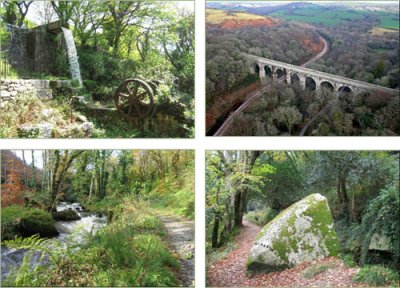
Picturesque historic valley laced with many trails
Midway between St. Austell and Lostwithiel
Email: folv@btinternet.com
Web: www.luxulyanvalley.co.uk
The Luxulyan Valley is a steep sided and thickly wooded valley, it is one of Cornwall's best kept secrets. The River Par runs down the valley along with the Par to Newquay railway line. It contains a major concentration of early 19th century industrial remains, and was designated as part of a World Heritage Site in 2006. The valley stretches south-east from the village of Luxulyan and has several footpaths and cycle trails along its length. It reaches as far as the edge of the built-up area around the town of St. Blazey.
Most of the industrial remains in the valley are the results of the endeavours of Joseph Treffry. Copper mining was booming in the area during the early 19th century, and Treffry was the owner of Fowey Consols mine, one of the deepest, richest and most important of the Cornish copper mines. The mine was situated to the east of the southern end of the Luxulyan Valley. At its peak in 1836 it was worked by six steam engines and seventeen water wheels and employing 1,680 workers.
In the late 1820's, Treffry started work on building the port of Par Harbour, which was completed in 1840. He then linked this to Pontsmill, at the southern end of the valley, by means of the Par Canal. A mineral tramway connected the canal head to the mine. A second tramway followed in 1835, via an inclined plane, a flat route along the eastern lip of the valley, and the major Treffry Viaduct built in 1844, across the valley to Luxulyan which was 648 feet long and 98 feet high. This second route served two major purposes, as it enabled Treffry to develop Carbeans and Colcerrow granite quarries in the upper valley, and was also used by a leat carrying water to supply the mine at Fowey Consols. Two further granite quarries, known as Rock Mill and Orchard, operated lower down in the valley. In 1870 these were linked to Pontsmill by a third tramway along the valley floor.
The 1835 tramway eventually became part of the Cornwall Minerals Railway which linked the English Channel ports of Par and Fowey via St. Blazey, with the china clay workings of central Cornwall, and to the Atlantic port of Newquay. As part of this process, the section of the route between Pontsmill and Luxulyan, with its incline and flat sections ideal for animal haulage, was replaced with a more gradually climbing route through the valley itself, more suited to locomotive haulage. The newer route is still in use, as part of the Atlantic Coast Line, and passes beneath the spans of the Treffry Viaduct that carried its predecessor. The older tramway routes remained in use to serve the various granite quarries until the early 20th century. The last stone came from Carbeans in 1933 but a few sections of Treffry's rails can still be found.
The thickly-wooded terrain of the Luxulyan Valley also played a major part in the early tin mining industry of Cornwall. The woods were important for making the charcoal that was needed in large quantities for smelting tin from the rich alluvial deposits on the moors to the north-west. Charcoal-burning platforms are to be found close to nearby Prideaux Castle.
The viaduct is managed by the Cornwall Heritage Trust.
Just north of the A390 road the bottom of Penpillick Hill at St. Blazey.
Opening TimesAll Year Admission Free |
Cycling in Cornwall Walks and Walking in Cornwall Cornwall's Railways Luxulyan
St. Austell St. Blazey Luxulyan Museum and Heritage Centre Cornwall's China Clay Industry Forestry Walks in Cornwall